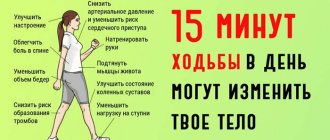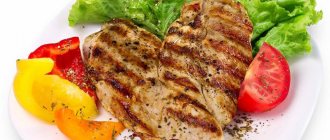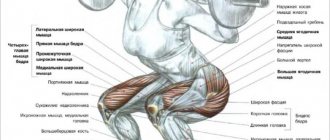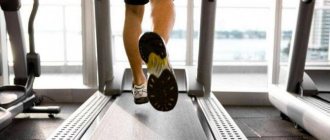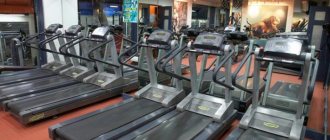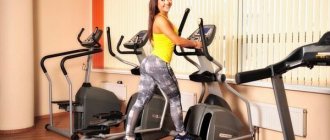How to avoid losing muscle while losing weight. How to maintain muscle while losing weight
Burn fat and maintain muscle mass! – does this task cause you difficulties and doubts? Many athletes and simply physically active people lose muscle and tone along with weight. This is often due to a strict diet for weight loss, a sudden change in exercise program and improper motivation. However, with proper training and nutrition, you can effectively dry out, make your body more sculpted and toned, while maintaining muscle mass.
https://youtu.be/8svt2IaK3a4
Causes of muscle loss when losing weight
Before you begin the process of losing weight, it is important to understand what factors and why, together with fat, destroy muscle fibers.
The first and most important mistake is restricting food, following a strict diet and significantly reducing calories. This leads to a lack of energy, weakness and apathy. To maintain energy balance and vital functions, the body begins to process fat. However, quite often protein, a component of muscles, is used as an alternative source of energy. This leads to loss of muscle mass, decreased physical strength and endurance.
Another reason for muscle loss during weight loss is intense cardio training with limited strength loads. Cardio keeps the body in good shape, improves the functioning of the heart and respiratory system, accelerates the fat burning process, but also negatively affects the condition of the muscles. In order to avoid such a serious mistake, consult with a coach who will draw up a competent program and help you achieve your goal with minimal losses.
Nutrition
The usual reduction in overall caloric intake will not help. The body will continue to accumulate fat tissue. It's all about an enzyme called LPL (lipoprotein lipase). It slows down metabolism, putting fat tissue in last place among energy sources. Unfortunately, the body uses muscles first. Therefore, when eating low-calorie foods, weight will decrease, but, as a rule, muscle mass will be burned.
To achieve your goal, the main thing is regular nutrition. Systematic meals mean eating at regular intervals. The best option is an interval of no more than three hours. Distribute calories evenly to avoid spikes in blood sugar. Metabolism will speed up, and the gastrointestinal tract will cope better with food.
How to get dry without losing muscle
In order not to lose muscle mass during the fat burning stage, follow simple rules.
First of all, organize your nutrition properly. Enrich your diet with high-quality protein. Adequate protein intake will build muscle and help burn fat. To fuel your body with protein, consume sufficient amounts of lean meat, fish, dairy and fermented milk products, and eggs. Protein shakes and sports supplements can serve as an additional source of protein.
Reduce calories gradually and do not create too large a deficit. This will cause stress, make you feel worse, and can trigger a quick breakdown. Do not reduce your daily calorie intake by more than 20%. This is the best option to lose weight and maintain muscle mass.
Limit your carbohydrate intake and completely eliminate foods with a high glycemic index. Do not overuse fats, however, do not exclude them from your diet altogether, as they support the functioning of the heart, the immune system and help maintain youth. Avoid alcohol, sweets, coffee and nicotine, and also limit your salt intake - it retains fluid and leads to swelling.
Don't forget about maintaining water balance. Drink enough fluids, and increase the dose of water consumed on training days.
Train properly. To maintain strength and maintain muscle mass, be sure to include strength training in your program. Perform exercises using sports equipment with different weights. However, do not reduce the number of approaches or the working weight.
Cardio training speeds up the process of losing weight and burning fat by enriching the body with oxygen. However, such loads can play a cruel joke on the muscles. Include in the program exercises that do not require long-term recovery - running, walking, exercise bike, stepper, etc. Such activities do not create a large load and do not injure muscles.
Rest and recovery are key components not only for muscle growth, but also for maintaining it and accelerating fat loss. Take more breaks between workouts. Remember, the body must fully recover, otherwise there is a high risk of developing a catabolic reaction.
To maintain health and normal functioning of the body, take vitamin and mineral complexes. Experts also recommend taking protein and amino acid supplements.
Following the principles of proper nutrition, regular training according to a well-designed program and the use of sports nutrition will allow you to burn fat while maintaining muscle mass. If you want to lose weight, do not go to great lengths - this will negatively affect not only your muscles, but also your health. Follow the basic rules, find the right motivation and confidently move towards your goal.
How to Lose Fat Without Losing Muscle
The biggest fear among strength athletes who diet is losing muscle mass and strength, so tailor your training to prevent this from happening.
First, load up your workouts with multi-muscle group exercises that work multiple areas of the body in unison. It's not clear what this is about?
– Multi-compound exercises include squats, bench work, rowing, upper abs, etc. – Single-compound exercises include arm swings, leg extensions, leg curls and similar movements in which movement occurs in only one joint.
Because multi-body part exercises use more muscle than single-compound exercises, they help maintain muscle mass, which supports your metabolic rate when dieting. Translation: You continue to burn calories and fight off the typical diet-induced metabolic rate decline.
You can also move heavy plates to the side when using compound movements. This results in the release of anabolic hormones, which can have a huge impact on muscle and fat burning. This doesn't mean you should avoid the same types of movements. And for all practical purposes, this is almost impossible to do with shoulder, biceps and triceps training. But keep your focus on the core exercises.
Your recipe for eliminating the last few grams of fat is to include additional vigorous activity. Thus, the right choice lies only in choosing the type and option: treadmill or bicycle.
We suggest you familiarize yourself with How a person should eat
Low-intensity stationary cardio machines were once the choice of pre-contest bodybuilders, and they performed these exercises for several hours a day. Now, something called high-intensity interval training (HIIT) is a fat-burning rage. In a typical HIIT session, you'll alternate periods of maximum effort with periods of decreased effort.
Typical ratio: 1:4; for example, 15 seconds of maximum effort followed by 60 seconds of retreat. HIIT increases your metabolism (meaning you burn more calories) not only during your workout, but also for up to 24 hours afterwards (known as excess post-workout oxygen consumption). This means that the total calories burned continue to accumulate throughout the day.
https://youtu.be/WJf_XKxgYsw
HIIT has demonstrated benefits in laboratory studies, namely improved body composition (decreased fat mass, increased lean mass). It improves cardiorespiratory fitness, physical performance, and insulin sensitivity, all good things if you're concerned about heart disease and type 2 diabetes.
Strenuous sessions at the gym. A more challenging approach to cardio. Calorie restricted diet. Suddenly, your body is faced with a fine line between losing fat and losing muscle that took a long time to build.
This is why adequate recovery becomes so important and necessary to maintain muscle while dieting. Taking time off from physical activity can help suppress cortisol levels, so getting a full night's sleep is especially important. What is considered a full night? Around 8 hours is still a good benchmark for sleep.
And then your victory in the pursuit of a sculpted body will be won, without sacrificing such valuable muscles!
Eat enough protein
Adequate daily protein intake is the single most important dietary requirement for muscle maintenance.
Even in the absence of a proper gym workout, you will only lose fat and not muscle mass as a result of eating more protein.
Maintain your strength level
The key requirement for strength training to lose fat without losing muscle is maintaining your current strength level, which is the amount of weight you lift with each exercise.
It's insanely stupid to lift heavy weights to build muscle and then switch to lighter weights for higher reps. When you start lifting light weights, your body thinks, “It looks like we only need to lift light weights now and those muscles that were built to lift heavy weights are no longer needed.
For example, if you currently bench press 30 kilograms, then throughout the fat loss phase you should stick to that 30 kilograms (or more if possible). The same goes for any other exercise.
Reduce your training frequency
If you do not recover properly after training, muscle mass is not gained, but lost. The workouts become more difficult, you become weaker, and the repetitions and weight lifted decrease.
To avoid this, reduce the number of repetitions or exercises you do, reduce the number of workouts per week.
Eat right before and after workouts
When your goal is to lose fat without losing muscle, the food you eat before and after your workouts is very important.
Don't cut calories too much
It is known that in order to lose fat, you need to create a calorie deficit. Deficiency can be small, moderate or large. A moderate deficit of about 20% below your previous calorie intake is ideal in most cases.
The main disadvantage of a large calorie deficit is that it will have the greatest negative impact on training and recovery. This means that cutting calories too much will increase muscle loss.
Those who have already lost enough fat can stick to a smaller calorie deficit.
Consume different amounts of calories on certain days
Consume more calories on training days and fewer on rest days. This way you will provide the body with energy when it is needed. This will allow you to better maintain muscle mass and strength while you lose fat.
Sometimes it is necessary to take a break from the diet for 1-2 weeks. There are both physical and psychological benefits to this. You will recover, and this will help maintain muscle mass and strength in the future.
Avoid excessive cardio or don't do it at all
Cardio training for building muscle mass is not important and may even be harmful. Yes, cardio is good for burning fat, but it can take away your ability to maintain muscle. They also lead to loss of strength.
30-60 minutes of low-intensity walking will burn calories well and you won't need a long recovery. You can also switch from running to an exercise bike. The muscles will have less damage, which will speed up recovery.
Vary the duration and intensity of your workouts. Do the exercises for 20-30 minutes. Do intervals of 10 seconds to two minutes in the active phase and from 20 seconds to 4 minutes in the rest phase.
Do cardio classes 3 times a week. And after such exercises, do not do strength exercises on the lower body for at least 24 hours from the moment they are completed, since strength training will not be effective due to lack of recovery.
This technique will burn fat faster and maintain maximum muscle mass.
If you've ever lost muscle while trying to lose fat or are just worried it might happen to you in the future, these tips will help you avoid it. The first two points are the most important to lose weight without losing muscle mass.
How to lose weight so that fat goes away, not muscle?
To force your body to burn fat and lose weight, you need to create a calorie deficit through diet and training. This means you need to consume fewer calories than your body needs to meet its current needs and/or burn more calories by exercising.
It describes in detail how to remove belly fat for a man after 30 years of age and older, taking into account a slower metabolism and a lower recovery rate.
The main problem is that a calorie deficit triggers such a frightening phenomenon for athletes as muscle catabolism. Luckily, you can maintain muscle while losing weight and burn fat without losing the muscle you've worked so hard to gain.
https://youtu.be/Gk2tL3-TLSw
Use moderately heavy loads at the beginning of your workout
There is a misconception that doing more reps per set will burn more calories. The problem is that you will have to reduce the load, and therefore you will begin to lose the incentive to increase strength and size.
Muscle growth is optimized by choosing a load that leads to exhaustion between 8 and 12 repetitions. Strength is maximized when you choose an even heavier load that causes fatigue between 1 and 6 reps. When you do 25 reps with a fairly light weight, the emphasis shifts to muscle endurance. This quality makes the muscle more aerobically efficient, but it has little effect on building muscle size.
While your goal is to maintain muscle and strength levels through dieting, nothing causes atrophy faster than eliminating the primary stimulus of muscle building. At least at the start of your workout, when you're not tired, provide that stimulus by choosing moderate to heavy exercise. Research shows that training with heavier weights (about 6 reps per set) helps you burn calories at a higher rate (longer than normal rest levels) for longer than using lighter loads.
Research
The study involved 15 male athletes (national and international level) who had at least 5 years of experience in competitive disciplines such as sprinting (100-200 m) and long jump. In other words, these were trained athletes with competitive experience, and not a couple of students sipping beer and pizza.
- 8 participants were placed in the fast fat burning group: 750 kcal less than required to maintain full performance. The calorie deficit was 24%.
- 7 participants were placed in the slow fat burning group: 300 kcal less than required to maintain full performance. The calorie deficit was 12%.
Research results
The overall decrease in body weight was 2.27 kg over 4 weeks. Athletes with a body fat percentage of 10% or more (abs are already visible, but the muscles are not split) were able to maintain lean muscle mass better than leaner athletes. Levels of testosterone, cortisol and sex hormone binding globulin did not change significantly. It's a good news.
Hormone balance plays a key role in this weight loss formula. Adequate testosterone levels are critical for your body to function properly (not to mention the emotional side of things). The study confirmed that proper testosterone levels in men lead to increased lean muscle mass and decreased fat and help increase libido.
But that is not all. Reducing body fat mass in combination with adequate hormone levels is not all that this diet has to offer. Participants who were in the fast fat burning group were even able to improve their performance in sports.
Long jumpers were able to improve their performance, and sprinters were able to reduce the time it took them to run the distance. This indicates an increase in the relative strength of athletes. Indeed, you can jump further and run faster when you don't have excess fat, which is extremely important for sports where you need to move your own body weight.
A few calculations
Every effective diet for burning fat and gaining muscle mass begins with the fact that you need to determine what calorie content will be your base. If you want to be precise, you can spend a couple of weeks counting and recording the number of calories you eat, but you can use a rougher estimate:
Body weight in kg x 33
Let's imagine that your weight is 90 kg:
- 90 kg x 33 = 2970 kcal per day
- Using a 24% deficit, you multiply your daily calorie intake by 0.76, because 100% - 24% = 76%
- 2970 kcal x 0.76 = 2257 kcal per day.
Very simple, isn't it?
Remember that, according to research, to achieve better results, burn fat without losing muscle, you need to reduce the number of calories you consume by 24% and most of this reduction (about 80%) should come from carbohydrates. If you think this is too much of a percentage, then just remember to keep your protein levels high in your diet. We'll talk about macronutrient balance in the next section.
Although the study was conducted over a 4-week time period, you can continue to use the above-mentioned calorie deficit until you reach your goals, as long as the diet works.
Carefully monitor your daily calorie deficit
Nothing says success like a scale.
However, this is most likely a warning sign that you are losing a significant amount of muscle and body fat. To minimize muscle loss while following a calorie-restricted diet, you can safely lose 0.5 to 1 percent of your body weight per week. This is equivalent to 0.4 – 0.9 kilograms per week for a 90 kg person. Steeper weight drops will likely cost you muscle loss.
https://youtu.be/LkmK4JiZ1sc
When starting a diet, it is important to determine how many calories you need to achieve a calorie deficit. A popular and convenient approach is to start with an online calculator that estimates your total daily energy expenditure.
Weigh yourself frequently so you can monitor your progress and make necessary adjustments. If your weight is not going down, you are not in a calorie deficit. However, if you lose a few pounds in the first 7-10 days (partially due to water loss in the first week), you're on the right track. Continue this plan until your weight reaches a stable level. At this point, reduce your calories by another 10 to 20 percent to deepen your calorie deficit.
Diet phase
Using the value of 2257 kcal per day, the diet should consist of:
40% calories from protein
- 2257 x 0.4 = 903 kcal
- One gram of protein contains 4 kcal, therefore, 903 / 4 = 226 grams of protein.
This means you need to consume 226 grams. protein per day.
30% calories from carbohydrates
- 2257 x 0.3 = 677 kcal
- One gram of carbohydrates contains 4 kcal, therefore 677 / 4 = 169 grams of carbohydrates
This means you need to consume 169 grams. carbohydrates per day.
30% calories from healthy fats
- 2257 x 0.3 = 677 kcal
- One gram of fat contains 9 kcal, therefore 677 / 9 = 75 grams of fat
You should consume 75 grams. fat per day.
Let's combine the obtained data:
- 2257 kcal per day;
- 226 gr. protein per day;
- 169 gr. carbohydrates per day;
- 75 gr. fat per day.
You can add one or two fasting weeks depending on how long you've been on the diet and how you feel overall. Monitor your changes and increase your calorie intake if you lose more than one kilogram per week after the first two weeks of following the program.
Remember, rapid loss of fat mass can also cause muscle loss, which is clearly the opposite of what you want. This fat loss program is designed to minimize muscle loss and changes in hormone levels to help maintain your athletic performance.
Won't you lose muscle if you lose weight quickly?
If we're talking about rapid weight loss, we need to start with the most important thing - muscle loss.
Most people think of it this way: “The only way to lose weight quickly is to fast and do grueling cardio that burns a lot of muscle.” And this is partly true.
Nutritional deficiencies accelerate muscle loss - this is one of the reasons why crash diets are so unhealthy. And overuse of cardio only makes the problem worse.
But how big is the calorie deficit? Exactly how much cardio is too much? And how do things change for athletes who eat more protein, as opposed to untrained, obese people who restrict their calorie intake?
Scientists at the University of Jyväskylä have found answers to these questions. To do this, they divided lean, athletic men (no more than 10% body fat) into two groups.
- One group ate about 300 fewer calories than they burned each day (about 12% lower than their total daily energy expenditure).
- The other was 750 calories less than she spent every day (about 24% lower).
Both groups were on a high protein diet and exercised as usual. After four weeks, the subjects who ate the least calories lost 1.8 kg of fat with little effect on muscle, while the 300-calorie deficit group lost little in both fat and muscle.
That is, doubling the calorie deficit resulted in a significant increase in fat loss, but not muscle loss. Note: the 750-deficient group did not fast, but consumed more than 2 thousand calories per day. It turns out that if you know what to do, you can increase your caloric deficit more aggressively without sacrificing muscle. .
How it works?
The presented diet is based on reducing carbohydrate intake without negatively affecting hormone levels. Carbohydrates and fats are two of the most important components needed to maintain proper levels of testosterone, which is needed for burning fat and building muscle.
Even though the amount of carbohydrates you consume is reduced, you are still providing the body with enough nutrients to maintain adequate hormone levels and not fall into a state of catabolism.
For example, a bodybuilder who wants to reduce both calories and carbohydrates can afford to reduce them significantly before competition week and peak fitness. Most competitive athletes follow a similar pattern to the one described above.
Natural athletes spend most of their preparation for competition maintaining relatively high testosterone levels. In the last couple of weeks before a competition, as you reduce your calorie and carbohydrate intake, your hormone levels can become very disrupted for a short period of time. This is the reason why bodybuilders often use recovery diets after competitions.
Hormonal balance will be restored when you increase your caloric intake (mostly from carbohydrates). The bodybuilder will begin adding new layers of muscle to his frame and will hope to surpass himself by the time he next takes the stage.
https://youtu.be/vPKXSmH5t1U
How to maintain muscle while losing weight
In this article, I will tell you how to preserve muscles while losing weight (burning fat, so-called cutting).
For those who don't know:
DRYING is fat burning, with minimal loss of muscle mass (muscle).
Those. The main goal of losing weight (cutting) is to BURN FAT with minimal muscle loss! Why are muscles so important? Yes, because the beauty of bodily forms consists of them (muscles), and not bones and skin. This is why you need to lose weight correctly, and not the way the vast majority of people lose weight...
This is why proper weight loss should occur primarily through the loss of body fat (fat). However, when cutting, you will, in any case, lose not only fat, but also some part of your precious muscles. There's nothing you can do about it, that's how our physiology works.
Look, losing weight (burning fat) is impossible without a proper weight loss diet. And a proper diet for weight loss implies a LACK OF CALORIES (calorie deficit).
As a result of a lack of calories (deficit) - the so-called. CATABOLISM, and as a result of catabolism, FAT is destroyed. But, in addition to fat, MUSCLES are also destroyed. Catabolism cannot affect one thing, for example, only FAT - without MUSCLE, or vice versa. Both are destroyed.
But! It is possible, and I will say more: this process (this muscle loss) SHOULD be minimized. You need to preserve as much muscle as possible. After all, this is in our interests; muscles are extremely important to us.
